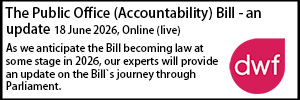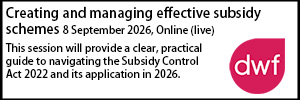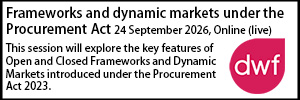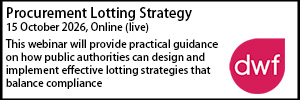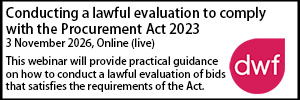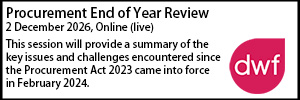Finding your way
- Details
 More than 100 procurement lawyers and professionals took part in Local Government Lawyer and Bevan Brittan’s survey. Philip Hoult reports on the findings.
More than 100 procurement lawyers and professionals took part in Local Government Lawyer and Bevan Brittan’s survey. Philip Hoult reports on the findings.
Ever since the Comprehensive Spending Review in 2010, local authorities have been struggling to square a seemingly impossible circle.
On the one hand, they are facing unprecedented cuts to the funding they receive from central government – far deeper than the reductions being imposed on Whitehall departments. On the other, they are having to cope with rising costs, particularly in adult care, that are beyond their control and accordingly difficult to keep a lid on.
Meanwhile, ministers are pressing councils to innovate, to find new ways of delivering services and generating economic growth. The Communities Secretary, Eric Pickles, has very vocally challenged authorities to take advantage of the general power of competence introduced by the Localism Act 2011 as well as other elements of the coalition’s localist programme, which he maintains has liberated councils.
At the same time, the Government has, in the Cabinet Office’s Francis Maude, a minister who has taken a rare degree of interest in issues relating to public procurement. Maude has sought to set the agenda on such matters as improving small and medium-sized enterprises’ access to contract opportunities, engaging with suppliers pre-procurement and increasing the number of mutuals providing public services.
It was against this backdrop that Local Government Lawyer and Bevan Brittan decided to survey procurement lawyers and professionals working in local government and for other contracting authorities. The aim was to gauge how they felt about applying the procurement rules at a time of such pressures.
Obstacle course
On the subject of innovation, respondents were asked whether they thought the procurement rules helped or hindered with the introduction of different models for delivering services, such as outsourcing, joint ventures, local asset-backed vehicles (or LABVs) and the like.
Some 44% of the more than 100 respondents to take part said the procurement rules were a ‘serious obstacle’ to implementing such structures, while a further 40% agreed with the statement that the rules were a ‘slight obstacle’ to implementing such structures but one that could be relatively easily overcome. Of the rest, 8% said the rules made no difference either way, 6% suggested they were a slight help and just 2% described them as a great help.
These results come in the same month that concerns were raised in a report on Lambeth Council’s radical plans for ‘co-operative commissioning’ about the need for the authority to find the right mechanisms to encourage and promote community-based delivery of services, but also ones that do “not fall foul of procurement legislation”.
The findings come as no surprise to Bevan Brittan partner Elizabeth Cooper. “They support our experience where local authorities struggle with tensions of trying to deliver services in new ways, including partnership working, and compliance with procurement (and state aid) rules which are perceived to be barriers,” she says. “Local authorities may also have potentially conflicting ambitions – a will to deliver their own services more efficiently, on their own or with others, and also to be able to trade their services externally.”
Elaine McLester, Procurement Improvement Manager at Surrey County Council, is similarly unsurprised by the results. “It is currently a major challenge to balance maintaining compliance with the Public Contracts Regulations 2006 and legal precedents (especially Teckal) with the ability to find new and ever more innovative and creative ways to deliver services with reduced budgets,” she says.
Cooper is nevertheless optimistic that solutions are achievable. “The first ‘hurdle’ to overcome is being clear on what your objectives are before commencing a procurement or signing up to commitments which may not be possible to deliver,” she suggests, adding: “Early engagement with potential partners – whether in the public, voluntary or private sector – will also assist authorities in achieving their objectives.”
Sweet talk
Such engagement has been something that Francis Maude in particular has been keen to promote. In May 2012, his department published a policy note – including a ‘mythbusting’ factsheet – aimed at giving contracting authorities the confidence to talk to suppliers pre-procurement.
The note argued that early pre-market engagement would enable them to better define their requirements and reduce their reliance on complex procedures. “Engaging with the market before starting the formal procurement process is best practice and helps to maximise value for money from the resulting procurement,” it added.
When asked whether they conduct pre-supplier engagement, more than half of the respondents (59%) said they do it ‘sometimes’, while 22% say they do so ‘often’ or ‘always’. Despite the Government’s promptings, however, a significant number of respondents – nearly one in five (19%) – said their organisations ‘rarely’ or ‘never’ engaged with suppliers in this way.
This comes as a surprise to Elaine McLester. “Surrey actively and routinely engages with suppliers, service users and stakeholders prior to commencing formal procurement processes,” she says. “This is in order to ensure co-design of services and best sourcing strategies with market knowledge, and to identify any opportunities.”
Charlotte Woods, Regeneration and Corporate Projects Lawyer at Eastbourne Borough Council, believes there is a greater chance of success and a reduction in the likelihood of a legal challenge where engagement happens early. “It also assists small and medium-sized enterprises (SMEs), which perhaps aren’t used to the processes involved, especially in high-level procurement exercises,” she argues.
Mutual feeling
Even higher on Maude’s agenda is a greater role for mutuals and social enterprises in the delivery of public services. The minister famously predicted in an interview with Public Finance magazine last year that one million public sector employees could be working in mutuals by 2015. A blizzard of Government initiatives have been launched, including a mutuals taskforce, a £10m mutuals support programme and, most recently, the appointment of 15 ‘mutuals ambassadors’ to provide advice to fledgling ventures.
But our survey suggests that progress remains patchy, in local government at least. Just 2% of respondents reported that their organisations had set up a staff mutual, while a further 2% said the process was underway and 11% revealed it was under active consideration. The vast majority of respondents (85%) said their organisations were yet to set up a staff mutual.
Respondents were also asked whether their organisations had already awarded contracts to social enterprises and/or staff mutuals. Some 28% said they had already done so, while a further 3% said the process was underway and 16% said it was under active consideration. Half (53%) said they had not made any such award nor started to do so. Of those to have awarded contracts to this type of organisation, almost all respondents (96%) said they had conducted a procurement exercise.
Eastbourne’s Woods is intrigued by the experience of those who have awarded contracts to mutuals. “I wonder if the respondent contracting authorities had assisted in the set up of these organisations at all, to what extent, and how long they were running before they were able to compete in a genuine competitive tender process,” she says. “I would expect this to be quite a difficult and complex task for new and inexperienced organisations.”
Aditi Tulpule, a commercial solicitor at the London Borough of Camden, had expected more organisations to have been through the process of establishing a staff mutual. “The low number of mutuals coming forward may be because of the challenges they face,” she says. “These include difficulties around identifying funding, especially because funding from the local authority could potentially create conflicts of interest.
“They may have to overcome issues such as a lack of commercial history and financial standing in any procurement. There is also the tension between the fact that procurement regulations are designed to ensure equal treatment and opportunities for all parties interested in bidding for public sector contracts, and active promotion of mutuals during a procurement process.”
At best, with one in 10 organisations giving mutuals active consideration, the survey could be seen as indicating a degree of momentum in the direction the Government is keen to promote.
It is no surprise, though, that Francis Maude is pressing the case – as part of the negotiations over the new EU procurement directive – for a time-limited exemption for mutuals from the rules, allowing them to become established before they are subject to full competition. Judging by reports on the October draft, however, his prospects for success would appear slim.
Small beer
Another issue that the Government has been keen to address is the extent to which SMEs are able to secure access to public sector procurement opportunities, which are worth an estimated £230bn a year.
In its May 2012 policy note the Cabinet Office highlighted a range of measures being taken such as the publishing of pipelines of future public procurement on the Contracts Finder site and plans for strengthening supply chain capabilities.
The Government has also published a public sector Procurement Pledge, one of whose promises was to give all types of potential providers, “including smaller providers”, simpler and more streamlined procurement processes. However, the Local Government Association went on to issue its own version, amid accusations that the Whitehall one was shaped around the interests of big business.
“In order to succeed, these reforms will need to be embraced across the public sector,” the Cabinet Office said about its programme. It added: “Government recognises that there is already much good practice in wider public sector procurement and is not seeking to mandate this approach outside central Government. However, Government believes that this new approach will stimulate economic growth and will enable all contracting authorities to achieve better vfm [value for money] through better solutions and more efficient procurement.”
But is this message getting through? Asked whether they had reviewed their tender procedures in light of the policy on better access for SMEs, almost half (48%) of the respondents said they had not. The remaining 52% had taken a variety of steps, such as splitting contracts into lots, reviewing turnover thresholds and simplifying pre-qualification questionnaires.
Interestingly, there was a similar level of division when it came to preparations for the introduction of the Public Services (Social Value) Act 2012, which is due to come into force next January.
Under the 2012 Act, which was brought in through a private member’s bill (but with Government support), contracting authorities are required to consider how procurement of services may improve the economic, social and environmental well-being of the relevant area.
Asked whether their tenders already incorporated questions designed to help meet this positive duty, 51% of respondents reported that they did and 49% said they did not.
Risky business
In addition to examining how the Government’s agenda was working in practice, the survey asked respondents to identify what they considered to be the greatest area of legal risk to procurement processes.
An array of issues were mentioned, notably a lack of understanding and knowledge of the rules, a reduction in resources (of which more later), and problems with the rules themselves (namely, the complexity of legislation and the speed at which case law develops). Some respondents also cited a failure to bring in lawyers at the right stage, unrealistic timescales for the procurement process, and human error.
“Certainly from a small authority’s viewpoint, the lack of resource and understanding are common problems,” admits one respondent. “There is often a lack of appreciation on the part of the contract managers (who know the service they are seeking best) of how the procurement process works and what can be gained from investing in it in the long run. “
By a considerable margin, however, the number one area of legal risk was evaluation. In Bevan Brittan’s Cooper’s experience, there are three common practices that create difficulties. “Firstly, there are local authorities which rush to OJEU without any detailed consideration of the appropriate selection or award criteria or how they will evaluate pre-qualification questionnaires (PQQs) and tenders,” she says.
“Secondly, there are those that set very detailed criteria and sub-criteria and rely on very complex evaluation processes and thirdly, there are those that set main criteria but realise part way through that the criteria aren’t right and attempt to back track.”
Cooper suggests that pre-OJEU consideration of relevant and proportionate criteria and testing out of the authority’s evaluation model will, to a certain degree, assist in reducing challenge risk. “What is key,” she adds, “is ensuring a robust procedure is followed with a clear audit trail to ensure you not only conduct a fair and transparent tender process but you are in a position to debrief unsuccessful applicants and bidders at all stages of the procurement.”
A strategic procurement manager at a county council we spoke to, agrees that while evaluation may be the greatest area of risk, it is something that can be managed effectively by having proper systems in place.
“If you are doing continual tenders for social care, the evaluation process doesn’t vary that much from one exercise to another and you can get some consistency,” he says. “It does, however, become more difficult for one-off procurements or in cases where the people involved are not accustomed to doing it.”
When it comes to debriefing, there appears to be little consensus in approach to the level of scoring information that organisations provide when sending an award notification (or standstill letter).
Two in five of the respondents said they give a full breakdown of scores as against all sub-criteria. The same number gives a breakdown of scores as against the main published criteria, while one in five (19%) give the overall headline score only.
Courting trouble
The backdrop to this, of course, is that – at a time when most contracting authorities can least afford it – the climate is now much more litigious.
More than half of respondents (52%) said their organisations had seen the number of legal challenges to their procurement processes increase over the past three years. Twelve percent said challenges had increased significantly, while 40% said they had increased slightly. In 46% of cases the number of legal challenges has stayed the same over this period, while just 2% reported a decrease in legal challenges.
Emily Heard, a commercial dispute resolution partner at Bevan Brittan, says the findings fit with the reported 20% increase in decided procurement challenge court cases between 2009 and 2011. “One of the causes of the increase in litigation is the shorter time period for challenge,” she explains. “If a bidder has a complaint, it is rare that discussion and disclosure will resolve that complaint in such a short space of time.”
Bidders consequently issue to protect their position, and the costs and effort involved in issuing are relatively low, Heard points out. Bidders also know that once they have issued they have an advantageous position as they will have triggered an automatic suspension of the contract award process.
“Many suppliers will now just ‘have a go’, issuing a standard ‘we wish to challenge’ letter regardless of whether there are any grounds,” complained one respondent.
The frustration felt by many respondents was that they have a strong record in dealing with challenges – four in five (80%) claimed to enjoy a success rate of 80% or more in defending the legal challenges they faced.
In the vast majority of cases, though, legal challenges do not end up in legal proceedings being issued. Almost all the respondents (95%) estimated that fewer than 20% of challenges end up going this far.
This fits with the experience of the strategic procurement manager we interviewed, who says his authority virtually never receives formal legal challenges where solicitors are involved and court proceedings are issued.
“However, we have seen a very significant increase in what you might call ‘semi-formal’ challenges where bidders come along and suggest that the process was not in accordance with the Public Contracts Regulations,” he says. “These can be quite resource intensive to deal with, although most of them go away relatively easily. Most are cases of sour grapes. While the bidders may hang it on the peg of a failure to apply the regulations, it usually comes down to them thinking they should have got more marks.”
Bevan Brittan’s Heard highlights a number of respondents’ comments suggesting that authorities can avoid litigation through discussion with the complainant in advance of proceedings being issued.
“Often bidders issue because they simply do not understand why they have not won, and a frank (and if necessary ‘without prejudice’) discussion about the final marks can help bidders to feel less cheated and less confident about initiating a formal challenge,” she says.
Paul Tonkin, a commercial contracts and procurement solicitor with extensive in-house experience in both local and central government, also often advises clients to do a hand-holding exercise with aggrieved bidders.
“We offer them a debrief and then do a real charm offensive, perhaps giving more information than what is required,” he says. “That tends to do a lot of good and take the sting out of the situation. In my experience, the people in these organisations are getting it in the neck from their chief executives and chief finance officers for losing a contract. They therefore try to blame the authority. If you tell them in a debrief where they could have improved their bid, that allows them a way out with everyone’s ego intact.”
Nevertheless, three in five of the respondents (60%) admitted to having had to rewind or abandon a procurement process as a result of a legal challenge in the last three years. Most of these authorities had only had to do it once or a small handful of times, although 3% had had to rewind or abandon processes on more than 10 occasions.
“Abandoning a procurement and starting again can be a viable and more cost-effective option in cases where the automatic suspension has been applied and you would need to seek removal of that suspension by interim injunction,” says Tonkin. “This is particularly the case for low end, relatively simple procurements. For complicated procurements, it is a different ball game.”
The fallout can be immense in the latter cases, something amply demonstrated by the Department for Transport’s recent decision to abandon – at an estimated cost of £40m – the West Coast mainline franchise award after a judicial review brought by Virgin Trains.
Left to chance
One respondent suggested that a more litigious environment can have its benefits, as it can make contracting authorities “try and ensure, more than ever, that everything is absolutely fireproof in the first place”.
But one in five (20%) have had to cope with a cut to their resources over this timeframe. “The reduction in the council’s resources can mean that legal services have less time to review tender documents,” admitted one respondent. “The reduction in resources can also mean that clients do not have sufficient time to prepare tender documents.”
As for the future, 41% expected their organisation to increase the resources allocated over the next three years. Almost the same number (40%) expected levels to stay the same, but one in five (19%) said the funding will be reduced.
There is no reason to believe, though, that demands on procurement teams and their lawyers will ease going forward. If anything, the evidence points in the other direction, so even those who are seeing resources maintained at their current level could be put under increasing strain.
Reforms to the procurement regime hold out the prospect of a simpler, more streamlined system. Once the new Procurement Directive is agreed, the UK will have up to 24 months to implement, so even with a push for early implementation the UK regulations will need to be put in place.
For ministers, this presents a headache. A survey of 91 businesses conducted by the CBI, the business lobbying organisation, this month saw respondents give a score of 8/10 when asked if Government policy was heading in the right direction. However, the scores for implementation of procurement reform and reducing the complexity of the procurement process were a lowly 5/10 and 3/10 respectively.
Worse still, there are those – notably Nottingham University’s Professor Sue Arrowsmith, the leading procurement academic – who have expressed concern that the European Commission’s proposals to simplify the regime will actually result in a set of rules that are far more complex than the current arrangements. “If these proposals are adopted, the resulting regime will truly be…. a ‘Frankenstein’s monster’,” Professor Arrowsmith said.
That is a sobering thought for contracting authorities and those who advise them on finding their way through this complex field.
Philip Hoult is Editor of Local Government Lawyer.
Sponsored articles
Unlocking legal talent
Walker Morris supports Tower Hamlets Council in first known Remediation Contribution Order application issued by local authority
Principal Lawyer - Planning, Property & Contract
Lawyer (Planning and Regulatory)
Contracts Lawyer
Senior Lawyer - Planning, Property & Contracts Team
Legal Director - Government and Public Sector
Locums
Poll
15-07-2026 11:00 am





































